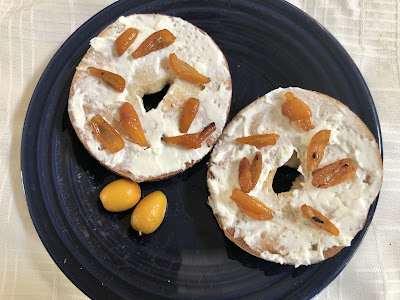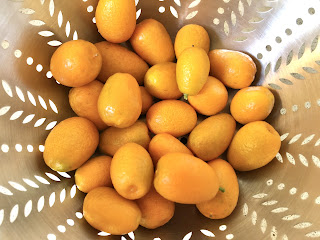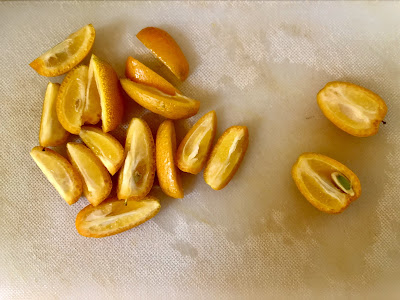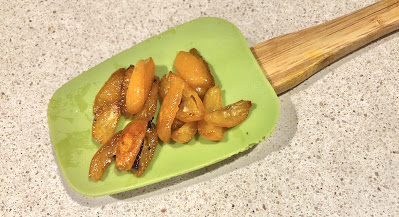
Recipe: Roasted, the tiny citrus fruit becomes a flavor giant

with cream cheese. (Photos: Kathy Morrison) |
As much as I love kumquats, the fruit on my tiny tree often is just ornamental, because there's only so much (I believed) that I can do with it. Sure, marmalade, but you really need a lot of them to make all that sugar mess worthwhile. And though I enjoy eating the sour-tart little fruits whole, not everyone does.
But the kumquats are ripening again, so I went looking for recipes. And certainly soon I will make the kumquat salsa recipe I found over at Simply Recipes, but I really had to try making roasted kumquats. The method I found uses just 1 cupful of fruit, plus olive oil and salt. That's it!
| One cup of ripe kumquats. |
So this recipe is more of a technique, and the result more of a condiment or garnish that a dish. But those little roasted fruit pieces pack a punch of flavor. The sourness disappears, and you're left with a tart-sweet concentration of fruit that plays well with a variety of foods.
Example: I was roasting the kumquats during the first part of the 49er-Green Bay playoff game, so on a whim tossed some of the cooked fruit on top of the grilled sausage that was my dinner. The kumquats added a

delicious punch to the whole-grain mustard and pickled onions that also dressed the not-spicy sausage.
Then, for breakfast, I sprinkled several pieces across my cream-cheese-covered bagel. Wow, that combination is going into the regular repertoire.
A note on prepping the kumquats: The seeds are edible, after all, so don't worry about popping all of them out when you slice or chop the fruit. And don't chop them too small -- halves or quarters are small enough, but not so much that they'll burn in the oven. Chop the fruit up some more after cooking if you want to sprinkle small bits.
Roasted kumquats
Makes about 1 cup
Ingredients:

1 cup washed kumquats (measured while whole)
2 teaspoons good-quality olive oil
1/8 teaspoon salt
Instructions:
Preheat the oven to 375 degrees. Slice the kumquats in half and let any loose seeds fall out. If the fruit is small, you can cook them that size, or quarter them lengthwise. If the fruit is large, chop it roughly but not too much. (See note above.)
Toss the prepped fruit with the olive oil and salt. Spread it on a baking sheet or shallow rimmed pan.
Roast for 20-25 minutes, stirring the fruit at about the 10-minute point. Continue roasting, and after 10 minutes check the fruit to make sure it's not at risk of burning. Remove from the oven if the fruit looks evenly roasted. Or, continue cooking for up to 5 more minutes.

|
Cool fruit slightly, then use immediately, or store in a covered container until ready to use. Refrigerate if you plan to use it the next day.
Easily doubled or tripled.
Comments
0 comments have been posted.Sacramento Digs Gardening to your inbox.
Food in My Back Yard Series
April 1: Don't be fooled by these garden myths
March 25: Fertilizer tips: How to 'feed' your vegetables for healthy growth
March 18: Time to give vegetable seedlings some more space
March 11: Ways to win the fight against weeds
March 4: Potatoes from the garden
Feb. 25: Plant a fruit tree now -- for later
Feb. 18: How to squeeze more food into less space
Feb. 11: When to plant? Consider staggering your transplants
Feb. 4: Starting in seed starting
Sites We Like
Garden Checklist for week of March 30
Your garden doesn’t mind April showers. Get busy now to enjoy those future flowers.
* Get ready to swing into action in the vegetable garden. As nights warm up over 50 degrees, start setting out tomato, pepper and eggplant transplants.
* From seed, plant beans, beets, cantaloupes, carrots, corn, cucumbers, melons, pumpkins, radishes and squash. (Soak beet seeds overnight in water for better germination,)
* Plant onion sets.
* In the flower garden, plant seeds for asters, cosmos, celosia, marigolds, salvia, sunflowers and zinnias.
* Transplant petunias, zinnias, geraniums and other summer bloomers.
* Plant perennials and dahlia tubers for summer bloom.
* Transplant lettuce and cabbage seedlings.
* April is the last chance to plant citrus trees such as dwarf orange, lemon and kumquat. These trees also look good in landscaping and provide fresh fruit in winter.
* Smell orange blossoms? Feed citrus trees with a low dose of balanced fertilizer (such as 10-10-10) during bloom to help set fruit. Keep an eye out for ants.
* Apply slow-release fertilizer to the lawn.